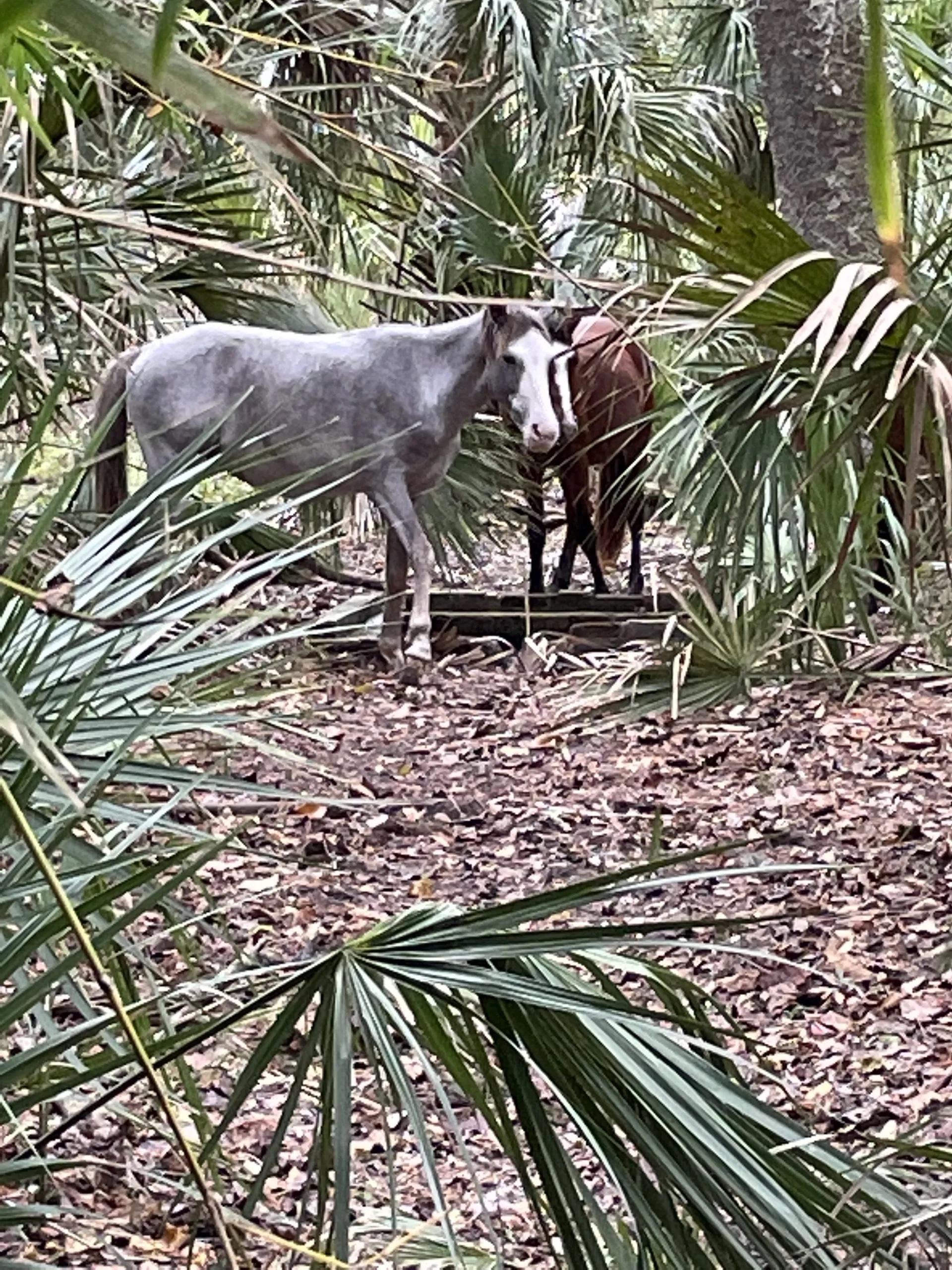
Are the feral horses on Cumberland Island National Seashore being properly managed?/The Current
Editor's note: The following story is from The Current, an independent, in-depth and investigative journalism website for Coastal Georgia.
The Trouble With Horses On Cumberland Island
Feral horses — especially the females — live a short, sickly life on Georgia’s largest barrier island, advocates say.
By Mary Landers, The Current
At least 150 feral horses roam Cumberland Island National Seashore.
Tourist sites highlight them. Visitors seek them out for photos. Artists celebrate them in paintings. The combination of island mystique and equine charisma is hard to resist.
Yet Cumberland's horses are not universally embraced. In fact, Athens-based Attorney Hal Wright has a message many of the island's equine enthusiasts don't want to hear: "Cumberland is bad for horses and horses are bad for Cumberland."
Wright represents the horses on Cumberland, the Georgia Equine Rescue League, the Georgia Horse Council and Cumberland resident Carol Ruckdeschel on whose behalf he sent a demand letter in late August to the National Park Service threatening to sue if the service didn't start managing the herd.
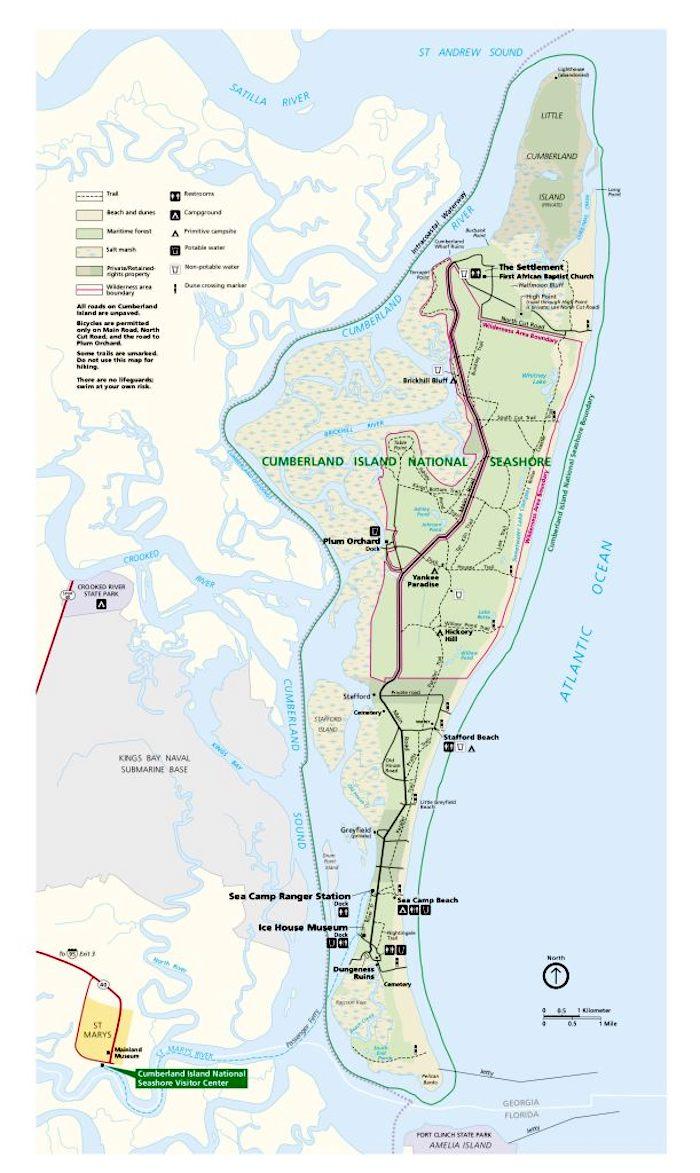
Cumberland Island National Seashore Map
Their argument boils down to this: Failing to care for or remove Cumberland's horses amounts to animal cruelty, which Georgia law forbids. They cite both Georgia’s Humane Care for Equines Act and the Georgia Equine Act.
The National Park Service hasn't responded to the August letter.
Horse History
Cumberland is the largest and southernmost of Georgia's barrier islands. It's loved for its sandy beaches scattered with driftwood "boneyards," for its maritime forest of twisted oaks, and for crumbling ruins of its gilded age mansion, Dungeness.
Visit Dungeness and you're almost guaranteed to see horses grazing in and around the decaying buildings. The postcard-perfect scene helps promote local tourism.
Humans began living on the island as early as 4,000 years ago. But Europeans and their horses didn't enter the scene until the 1500s when the Spanish built a mission and fort there. More horses came after the arrival of Gen. James E. Oglethorpe, founder of the English colony of Georgia, who claimed the island in 1736 and named it Cumberland. By 1788, "free-roaming horses were reported on Cumberland Island," a letter from the time reported.
A feral herd continued to exist on Cumberland through the plantation era when enslaved people grew sea island cotton there. The horse population declined during the Civil War but increased through the gilded era when Cumberland became first the winter retreat and then main residence for steel magnate Thomas Carnegie, his wife Lucy and their nine children. At one point, over 50 horses were stabled at Dungeness alone, according to the Cumberland Island National Seashore website.
"Throughout the 1900s, new stock was introduced and some horses were taken off the island for sale," the website states. "Property owners on Cumberland managed horses as free ranging livestock from the 1940s until the 1960s. By the time the park was established in 1972, horses had become feral on the island."
With the National Seashore designation came research and documentation of the island's non-native species, including the feral horse. First, they were counted.
"NPS has monitored the island’s horses annually with population census techniques since 1981," Superintendent Gary Ingram and Cumberland staff wrote in an email response to The Current. "Based on this, the herd appears to be stable at between 150 and 170 animals."
Genetic testing on Cumberland's horses published in 1991 indicated they are genetically similar to breeds including the Tennessee Walking horse, Quarter Horse, Arabian, and Paso Fino. The researchers noted that "we do not know if the horses present on the island shortly after the Revolutionary War contributed significantly to the current gene pool or if the population is of more recent origin."
The Island Harms The Horses
Regardless of their bloodlines, the horses are a draw for island visitors like Atlanta area resident Keiara Turner. She was curious about them as she boarded the 9 a.m. ferry from St. Marys to Cumberland in mid November. Turner had been on this trip three times before, first as a fifth grader. She was eager to see the horses again.
"Some are brown, some are white with black spots, some are all black -- those are pretty," she said.
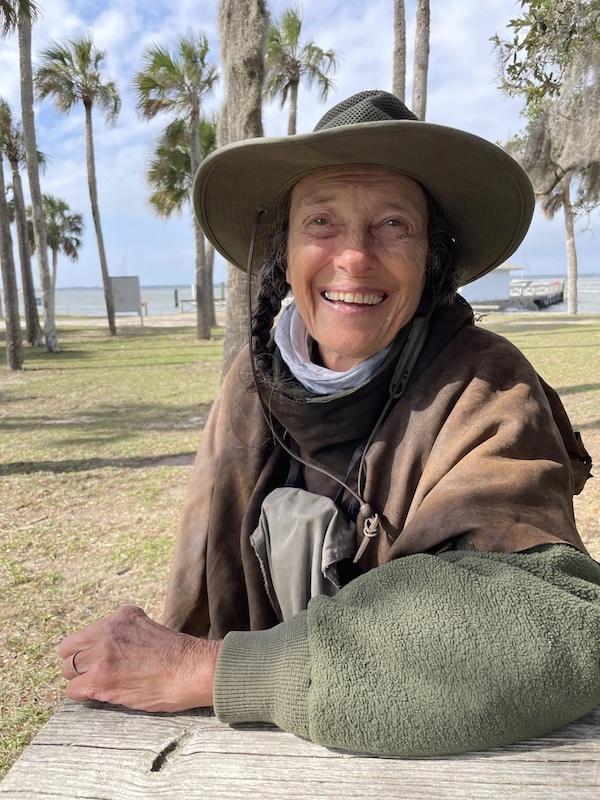
Carol Ruckdeschel/The Current, Mary Landers
But visitors don't see the whole story, said Carol Ruckdeschel, a biologist and naturalist who resides on the island. Now 81, she's lived on Cumberland since the 1970s studying its sea turtles and regularly surveying the beaches for dead animals she necropsies, documenting her findings.
"If you just come as a day visitor, and walk around and look at them, and they look fine, and everything's good, and you leave with a nice, warm, fuzzy feeling," she said. "But if you live with them, it's entirely different. And they really have an incredibly difficult life."
Patty Livingston, president of the Georgia Horse Council and the Georgia Equine Rescue League, makes a similar point. Both women focus their concern on Cumberland's female horses.
"Not all the horses on the island are skinny. The babies are in pretty good shape. And of course the stallions are (in good shape) and you're easily able to pick them out," said Livingston, whose nonprofit Georgia Equine Rescue League cares for horses impounded by the Georgia Department of Agriculture. "But you're also able to easily pick out the mares because none of them are at an adequate weight. And if that was anywhere else, the Department of Agriculture or law enforcement would be called."
Mares frequently get pregnant as yearlings before they're full grown themselves.
"I have seen gruesome pictures of them dying in full birth,' Ruckdeschel said. "I mean, they just can't pass it."
If the young mare lives through the birth, she can get pregnant as quickly as two weeks later. So the females face a cycle of pregnancy, birth and suckling that requires more nourishment than the island provides.
As the demand letter states, “Cumberland Island lacks adequate food resources to sustain an equine population of any number. The Cumberland horses consume Spanish moss,
smooth cordgrass, sea oats and sedge, all native to the island and of marginal nutritional
value.”
It’s painful to watch these mares, Ruckdeschel said.
“They’re eating for themselves, the one inside of them, and their yearling, which is probably still suckling,” she said. “And so they go down fast. They really have a hard time. Once I watched a mare and a little foal, and it was right where I was always going out to the beach, and I could see it, and she was getting skinnier and skinnier. She was just a walking skeleton.”
The next week both mother and baby were dead.
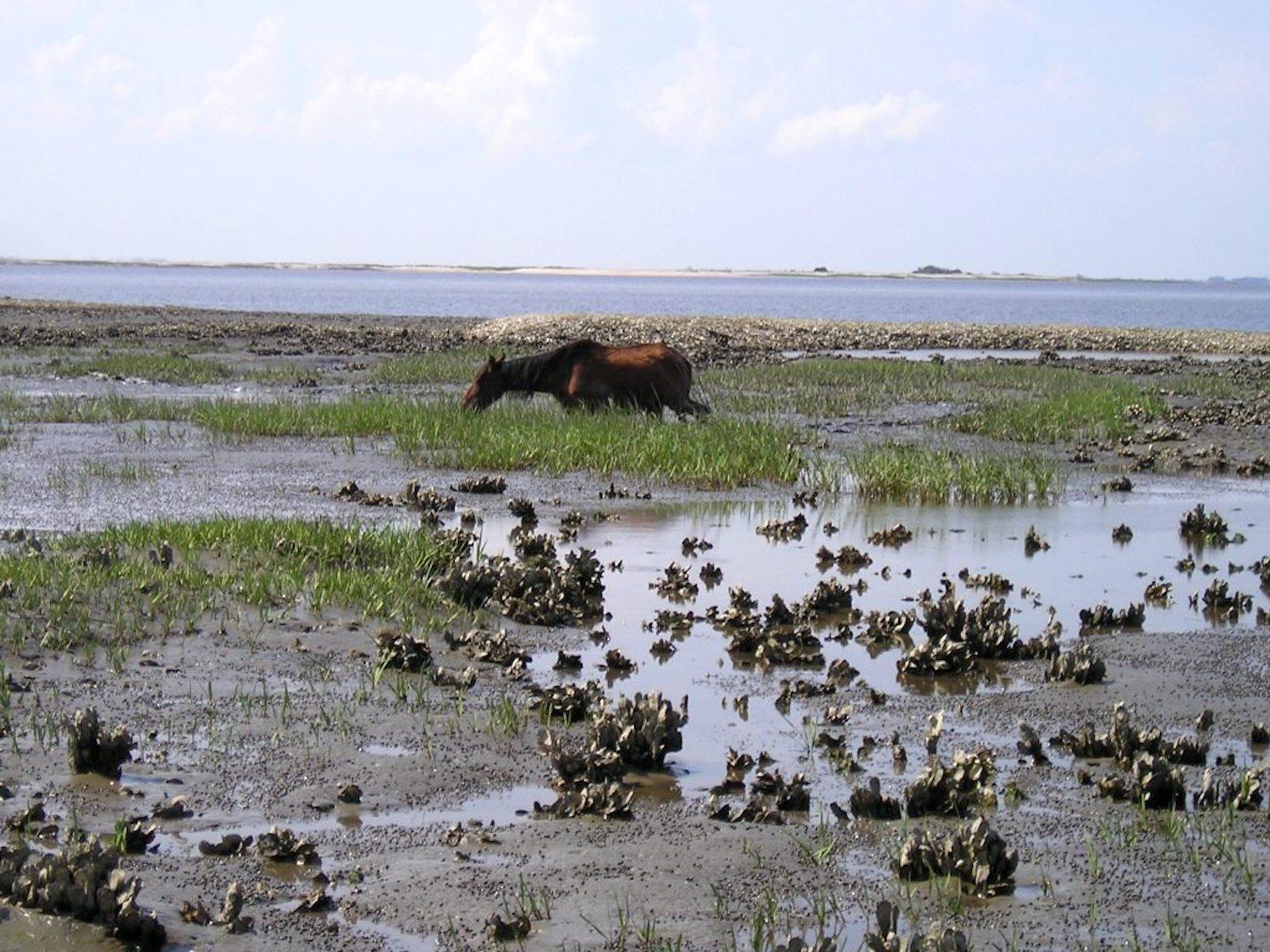
Cumberland Island feral horse feeding on marsh grass in 2005/Carol Ruckdeschel
And that’s far from the only way horses die on Cumberland, where the life expectancy of a horse is 8 or 9 years. Domestic horses typically live to 25-30 years.
“I’ve seen them bogged down in the marsh and the tide come in and drown them. Alligators get them. They get caught between two trees like this,” Ruckdeschel said, pointing to two close-growing trees near the Dungeness ferry dock, “and die because they can’t get out.”
Their manes and tales are a liability in the thick underbrush of a maritime forest. They sometimes get caught in grapevines or briars and die, Ruckdeschel said. Tourists don’t see it because it occurs off the paths.
She once discovered a filly abandoned by its mother, lying alone in the marsh.
“That’s really unusual for parents to abandon. I mean, they’ve got to be a lost cause,” she said. “And then I realized how the feet were curled up on the ends.”
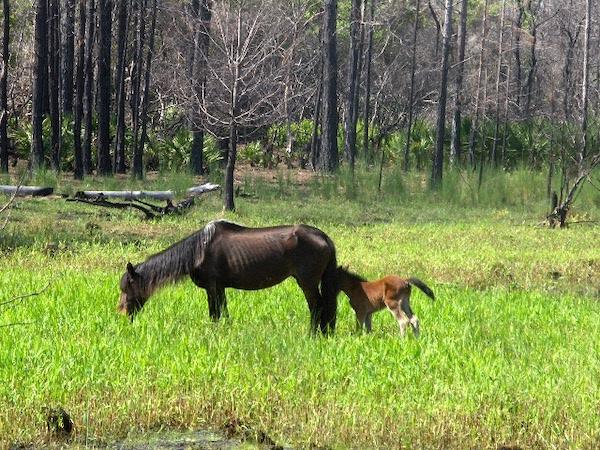
Both this mare and her foal died shortly after the photo was taken. Female horses have an especially tough time on Cumberland. They are often pregnant or nursing from a young age and have trouble finding enough to eat/Carol Ruckdeschel
They looked like elf slippers. It’s a condition called laminitis that can occur when a horse is deprived of hard surfaces on which to walk, she said. Ruckdeschel eased the filly into makeshift horse carrier fashioned from a boat trailer lined, drove gingerly over the dirt roads home and nursed her back to health, eventually rehoming her on the mainland.
Last fall Ruckdeschel discovered a dead horse with a live oak branch impaling its neck. Its lungs were infected from the injury, she discovered on an internal examination.
The horses are prone to mosquito-borne Eastern equine encephalitis, which can give them “the blind staggers.”
“They drool or hold their head down and they just walk around bumping into things and finally die,” Ruckdeschel said.
Domestic horses are vaccinated against this disease, but the Cumberland horses don’t receive any veterinary care.
When Cumberland visitors have a trained eye, they see the horses more like Ruckdeschel and Livingston do. That was the case with Veterinarian Tom Jones, of Ashburn, Va., who toured the island with friends on a chilly November day. As he waited for the ferry back to St. Marys he offered his assessment.
“A couple of them looked OK, but a couple looked dangerously thin,” he said.
Living on a barrier island likely compounds the issues horses typically have with wear and tear on their teeth and with their digestion, he said.
“It’s not much of a life for a horse,” Jones said.
‘No Significant Die Off’
Cumberland’s Superintendent Gary Ingram declined The Current’s request for an interview. He and other park staff instead answered questions submitted by email, responding after more than two months.
They argue the herd has adjusted to Cumberland and functions like a wild population.
“Condition ratings for observed animals have always been predominantly in the “good” to “moderate” categories,” they wrote. “At no time during the last 41+ years has there been a significant die-off or anything indicating that the overall health of the herd was in extremely poor condition. The island is 36,000 acres in size with half of the acreage in upland habitat and the other half in fresh and brackish water marsh habitat. The herd appears to have stabilized its numbers relative to the amount of natural food available on the island.”
The horse advocates are pushing the Park Service to act before there’s a disaster.
“NPS seems to take the position that the island is not bad for the horses because the horses are not in ‘extremely poor condition’ and because there has not been a herd die off,” wrote Wright, the attorney. “This is an extremely low bar and one which is challenged by the Georgia Equine Rescue League and the Georgia Horse Council.”
The seashore staff response also states the herd has had minimal to no care from human during most of its time on the island.
“Cumberland’s horses are not domestic animals that have been abandoned, nor are they accustomed to being fed,” the staff wrote. “Instead, they function as a wild population that has adapted to living conditions on a barrier island and are subject to all of the natural forces that affect wildlife.”
Wright rejects this response as “incorrect and self-serving.”
“If the Cumberland horses are not domestic horses, what are they?” he wrote. “If they are not domestic horses which have been abandoned by their previous owners (the Carnegies and their extended family) then are they domestic horses that still belong to these families? Or did these families do something other than abandon these horses? To be clear, there is no debating the Carnegies and the families on the island brought to the island and released hundreds of horses on the island.”
Horses Harm The Island
Better known than the effect of the island on horses is the reverse. Researchers have long documented the harm the horses do to the nearly 18-mile-long barrier island.
Studies have found that their grazing significantly reduces plant cover, growth, and reproduction, apparently altering what plants grow in these areas, a 2018 National Park Service report documents.
“The feral horse herd likely consumes between 200 to 400 tons of vegetation each year and removes up to 98% of vegetation in areas they frequent,” states the draft Visitor Use Management Plan for Cumberland, released in October. A dramatic photo from one study makes it even more clear, showing a denuded area where horses grazed adjacent to a lush one where they were kept out.

Through the use of exclosures (fenced areas that prevent horses from grazing there) biologists have been able to document the impact of horses on the island’s landscape/NPS photo
Grazing is likely increasing the vulnerability of dunes and salt marshes to erosion and storm damage.
A bipartisan Feb. 8 letter from U.S. Sen. Jon Ossoff and U.S. Rep. Buddy Carter, both of Georgia, urges Secretary of the Interior Deb Haaland to investigate shoreline erosion on Cumberland. Despite the horses’ connection to dune damage, the letter lists “wild horses” among the island’s assets. Ossoff Spokesman Jake Best told The Current the senator’s office has “not studied the issue in depth.”
Horses alter the soil in wetlands, compacting it with their weight. Their waste, evident to any day tripper, adds excess nutrients to wetlands and ponds and can contaminate waters with pathogens, including E. coli bacteria. All these impacts spell trouble for the island’s hundreds of native plants and animal species.
Nearly 20 years ago Lary Dilsaver, now an emeritus professor of geography at the University of Alabama, wrote the definitive history of Cumberland with “Cumberland Island National Seashore: A History of Conservation Conflict.” He detailed the debate over horse management as well as the political wrangling over the island. Park management was moving toward managing the herd in the 1990s but delayed making a decision when there was a public outcry against it.
Then-Congressman Jack Kingston stepped in. “He toured the island with one of the residents and suddenly claimed that the horse numbers had decreased and that he could find little evidence of damage caused by them,” Dilsaver wrote. “Without discussing the issue with the Park Service, he added a rider to the fiscal year 1997 budget bill banning all horse management at Cumberland Island National Seashore.”
Dilsaver concludes in his book published in 2004, “At present the Park Service continues to take no action with horses other than the annual census.”
The horse advocates’ demand letter picks up the story here: “Representative Kingston’s rider expired in 1997,” the letter states. “Since that time, NPS has taken no further steps to manage, care for, or otherwise control the island’s feral horses.”
“The ‘1996’ plan has expired and cannot be reactivated,” Ingram and park staffers told The Current without further explanation.
Despite its own documentation of the harm the horses do, a draft management plan on the books, and a mandate to protect the island’s native species, the draft Visitor Use Management Plan the Park Service released in October offers no vision for the horses going forward.
“Feral populations of hogs and horses roam freely on the island, and while Cumberland Island National Seashore has established the objective of eradicating the hog population, feral horses currently are not managed,” it states.
That hog management has a connection to Hal Wright.
“NPS was forced to further control feral hogs through a legal action brought by myself very similar to the one being threatened,” Wright wrote.
The Park Service points to the damage hogs do to sea turtle nests as the reason to manage that feral species. Duly noted, Wright said.
“An additional more detailed notice letter under the Endangered Species Act has been sent to NPS setting forth how NPS’s failures to manage the island horses is threatening the island’s listed species, including their critical habitat,” he wrote.
Cattle also once roamed the island. After they were removed in the 70s the beach dune system recovered significantly as did the underbrush in the forested areas, Ruckdeschel said.
And Theodore Roosevelt National Park in North Dakota has recently proposed eliminating its feral horses and domestic livestock, National Parks Traveler reports.
Solutions Proposed
Wright and the other horse advocates propose that the NPS start caring for the horses right away, providing food, water and medical care “to bring the herd to the level of care consistent with Georgia’s Humane Care for Equines Act.”
They then want the entire herd removed over the course of eight years by the use of contraceptive darting of the mares and by a round up and adoption of young horses.
The lack of a response so far tells Wright the effort is not being received as a “friendly suit,” that will help them resolve the issue.
Ingram and park staffers said they’re aware of “varied public opinion concerning Cumberland Island’s feral horse population and will seek to incorporate the public’s input on any future plans to address feral horse management.”
To Wright, that response signals the possibility of an analysis that seeks public input before the Park Service takes action. Instead, the demand letter urges an expedited process that doesn’t require public comment because of the threat the feral horses pose to the island’s natural habitat.
The Southern Environmental Law Center also urged a reduction in the herd in its recent comments on the Visitor Use Management Plan, urging a public education campaign to explain the horses’ plight.
“If such a campaign were executed successfully, the Park Service may build public support for taking appropriate action such as gelding the stallions, so the mares are not continually in foal,” SELC writes. “If the herd was reduced in size, the impacts of the horses on the ecological integrity of the island could also be improved, as well as the health of the horses.”
Park visitors who celebrate the horses and the commercial tour guides who profit from them are among those who may object. The Park Service web site downplays the horses’ presence, but an authorized contractor, Molly’s Old South Tours, plays them up even in the tour name: “Cumberland Island Walking Tour: Haunting Ruins and Wild Horses.” Some cruises out of Fernandina and Amelia Island also feature the horse in their promotional material.
Representatives of Greyfield Inn, the only commercial establishment on Cumberland Island, declined to comment. The $400-a-night retreat overseen by members of the Carnegie family doesn’t shy away from the horses on its web site, where a photo shows seven horses grazing among palm trees against a backdrop of marsh. “Ride in the back of our custom naturalist’s truck on the way to view the secrets of Cumberland: historical ruins, wild horses, and lush maritime forests,” the copy reads.
Gogo Ferguson, a Carnegie descendant who creates jewelry inspired by Cumberland and who lives on the island, emphasized the long history of horses on the island and the population’s stability.
“I am very cautious of anyone determining who can stay and who has to go as it has been a very symbiotic life for all of us, all inhabitants of Cumberland,” she wrote in an email. “It is when we start tampering with introducing animals, sterilizing horses (an utter disaster and with so many tragic consequences) decisions with no long term studies, that cause problems.”
Knowing that the horses evoke emotional and political responses, Ruckdeschel, Livingston and Wright expect a fight.
Livingston sees a path forward with her organization working with the Department of Agriculture to assist Cumberland’s horses.
“I’m hoping that’s what will happen,” she said. “But I’m just fastening my chin strap.”

 Support Essential Coverage of Essential Places
Support Essential Coverage of Essential Places
Comments
Good article on Cumberland horses.
I hate to think of animals being harmed just because tourists like them and the horses are used for profit.
please print follow up articles as time goes on
I just got back from a visit to the island with the main motivating purpose for traveling there was to see those horses. I unlike the people you described did not leave with a warm fuzzy feeling. I have been since dreaming of what I would do if I had money to take the newborns at least from the island and bring them to a new and more nurturing home. These horses were not meant to live this kind of life. It is cruel to continue to allow this. I stayed at a hotel in St Mary's and while I was there I picked up a magazine called Historic St Mary's Magazine. Inside were articles (advertisements) With beautiful photos of these horses. In the short amount of time that I was in this town it was obvious to me that so many hands are profiting off these poor horses. It made me sick of the entire arrangement. To realize that I was lured because of my love of horses to this place that I now think of as cursed and probably due to the horrific acts alone of this injustice. I sit here with a coffee table book that I purchased many months ago called Wild Horses Of Cumberland Island and I now notice the way the photographer captured these horses not of the skin and bones and ribs sticking out or the hind hunches bare and mangled or the carcass that I came across of what appeared to be the remains of a foal never more. They too profited off these poor souls. I am so sickened. I had no idea. I had no idea. I don't even know what I thought. I guess I didn't. I cannot unsee or unfeel what is clear to me now. I came across this article in hopes of finding something or someone out there that had a voice to change this and I came across this article. I wish there was more being done. Is it wrong of me to despise the inhabits of this island and the National Parks Service for allowing this? They are responsible. It is wrong. It is wrong. I know that no animals were meant to sacrifice this way.
We visited the wild horses there around 33 years ago. Humans try and say that wild horses are not native to the US, ranchers love that... but, LaBrea Tar pits show that modern horses were here. They were one of the first animals humans drove to extinction. I'm tired of the excuses for the sick roundups. The horses have managed to survive there for 100's of years. Of course wild is harder than domestic. Because I see the Interior Department brutally removing them all over the country, I distrust them greatly. What has happened to our Grey Wolves is also a tragedy. If I thought they were going to give veternary care. If I thought they wouldn't end up like the American Mustang out west, auctioned and sent to Canada or Mexico to slaughter.. I might think intentions were good here. They have not been with any wild horse population. I realize these islands don't have cattle. but often our public lands are used by the cattlemen's association for free grazing, and they eat native plants. the horses in bad shape etc. too remove our horses, and then there are more dmn cattle. Please leave them be.
As an owner of several horses in my life I agree explicitly with everything that you have shared from your heart.
There is a season for everything under the sun and it's time for the season of change for these beautiful horses. They are not being cared for properly, and the environment is not conducive to a healthy existence.